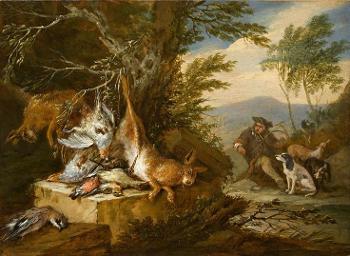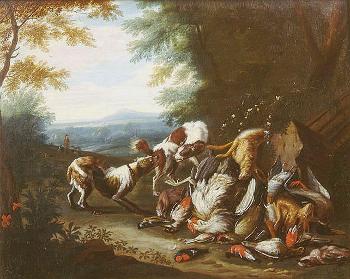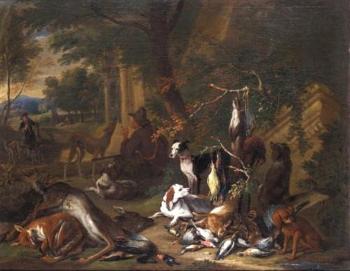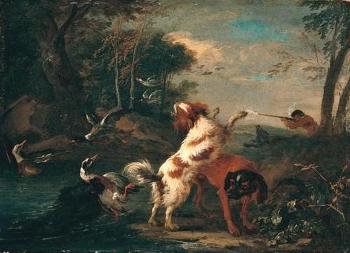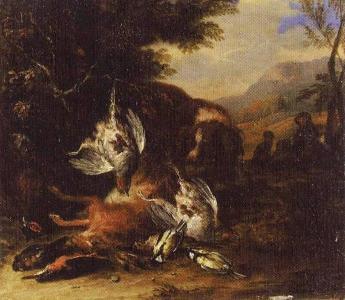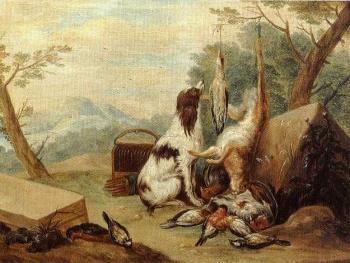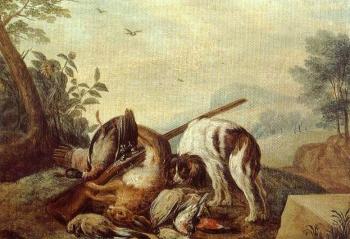"All paintings are fully documented with texts and photographs of comparative items. All this information is removed from our website once the painting is sold".
In short
Our Adriaen de Gryef was the son of an important Dutch still life painter, Jacques de Claeuw. “Gryef” refers to “griffe” in French, which is the translation of the Dutch word “claeuw”: claw.
In his turn de Gryef became a prolific, popular painter of mostly relatively small hunting scenes: hunters and/or their dogs at rest near the spoils of hunt. Although he was born in Leiden in Holland, he did spent the largest part of his career in Flanders.
Our early painting, dating from the last quarter of the 17th century, shows the influence of the Antwerp specialist of hunting still lifes Jan Fyt.
About Adriaen de Gryef
Dutch-Flemish painter
Leiden (Holland), 1657 – 1715 or in/after 1722, Brussels
His last name is sometimes spelt Gryeff.
Son and pupil of the famous Dutch still life painter Jacques de Claeuw, called "Grief". “Claeuw” in Dutch and “griffe” in French both mean “claw”.
Painter of hunting still lifes : the early ones resemble those of Jan Fyt (Antwerp 1611 – 1661 Antwerp), the later ones those of Pieter Gysels. Occasionally he also painted fruit still lifes and barn scenes.
When Adriaen was about 10 years old the family moved within the Dutch Republic to Zeeland.
Recorded in 1687 as a painter joining the Guild of Saint Luke in Ghent, Flanders.
Left Ghent soon for Antwerp, where he married a wealthy woman in 1689.
Active in Brussels in 1690.
In 1694 first active in Antwerp, then in his native Leiden, so back in the Dutch Republic.
Left again for Antwerp, was there already in 1698 and joined the Guild in 1699/1700.
A few years later he reportedly moved to Brussels, where he is thought to have spent the rest of his life.
According to Jan De Maere (1994, p. 188) Adriaen de Gryef died in 1715. According to Adriaan van der Willigen and Fred Meijer (2003, p. 96) he must have died in or after 1722. They base this on a painting in the Musée des Beaux-Arts in Tournai which is dated 1622: they think it could be typical of his latter-day production in Brussels although the size is exceptional and the subject somewhat unusual (a mix of dead and live birds).
Paintings by de Gryef can be found in numerous European museums.
About our painting
As our painting clearly shows the influence of Jan Fyt, it must be an early work. De Gryef shows us here already his technical mastery and bold facility in the representation of animals, of their furs and also of the plumes of birds. Our painter has also paid a lot of attention to the landscape setting.
Hunting had always been a very prestigious sport, limited as much as possible to the nobility. It was actually prohibited for the lower classes of society to hunt and poachers and other illegitimate hunters were severely prosecuted. Through the acquisition of game pieces the members of the urban elite associated themselves with a lifestyle reserved for aristocrats.
About the provenance of our painting
There are two old labels attached at the backside, one to the panel and one to the frame.
One says that the painting was bought at Christie’s London in 1959.
The other one says that the painting sat in Northwick Park Collection.
That collection of over 1.400 paintings at Northwick Park was largely formed by the 2nd Lord Northwick (1769 – 1859). As he had remained unmarried his complete collection was auctioned off over the course of 18 days. A large amount of the paintings were actually bought by his nephew, who inherited the title of 3rd Lord Northwick.
Sales of the Northwick Park collection were held in 1859, 1864 and 1965. Between 21 and 23 June 1965 (not 1959 as erroneously written on the 2nd label) the property of the late Captain E.G. Spencer-Churchill, M.C. was indeed sold at Christie’s London. He was the grandson of the 3rd Baron Northwick.
Why should you buy this painting?
Because it is a fully signed, lively, Late Baroque snapshot of the hunt, set against a beautiful landscape.

